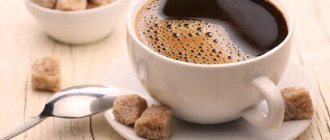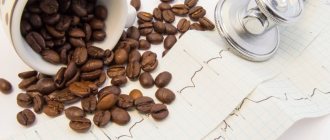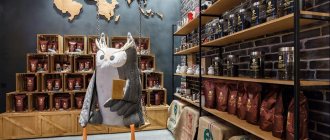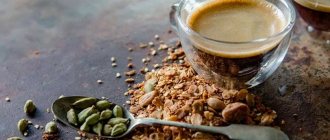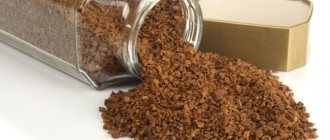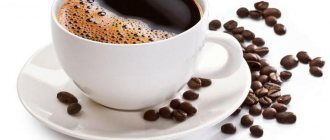Coffee beans are a medium-calorie product; 100 g contains about 200-300 kcal. The energy value changes in accordance with the additives used (granulated sugar, maple syrup, cinnamon, chocolate chips, milk, ice cream), and the degree of roasting of the coffee powder. The calorie content differs depending on the type of drink (latte, ice, mocaccino, mocha, cappuccino) and reaches 100-420 kcal.
How many calories are in instant coffee?
Instant coffee is very popular among consumers. About half of drink lovers prefer instant granulated or freeze-dried coffee, since it is easy and quick to prepare. Although in terms of taste and the percentage of natural raw materials, it is in many ways inferior to other types of coffee.
The calorie content of instant coffee without sugar varies between 100-250 kcal per 100 grams of dry product. When prepared, naturally, the dry product is diluted in water, and not all 100 grams are consumed at a time, so the calorie content of a cup of coffee is much less. It depends on various factors: the concentration of the drink (some people like it strong, others prefer a lower strength), the type of coffee, the manufacturer and the processing technology. On average, 1 teaspoon of dry product is used per cup, which equals an average of 10 kcal.
In stores you can buy instant coffee in bags. It is convenient to take it on the road or to work. It can be without additives, or with sugar or 3 in 1 (sugar and milk powder). One serving of instant coffee with sugar is approximately 45 kcal. Although in its pure form the product is low in calories - about 17 kcal.
Popular 3-in-1 bags are the most high-calorie of the range of disposable bagged products. Sugar and cream play a vital role here. For 20 grams of mixture (1 sachet), sugar makes up about half the weight, that is, 10 grams is 38 kcal. Cream is used of plant origin due to its low cost compared to natural products. Such cream is higher in calories - about 30 kcal per mug. Thus, the calorie content of McCoffee, Jacobs coffee and other popular brands of instant coffee with sugar and cream is about 70 kcal.
Coffee in the diet of those watching their figure
The healthiest thing, of course, is classic black coffee without sugar, with a calorie content of 2 kcal per 100 ml of a small mug. It is enough for the final awakening, receiving all the useful vitamins and microelements, as well as satisfying the need for caffeine. It is not recommended to increase the daily dose of the drink, not only for reasons of calorie content, since there is no need to be interested in how many calories are in coffee when drinking it without additives. Increasing the “dose” threatens caffeine addiction, which negatively affects the nervous and cardiovascular systems: if in small quantities this drink has a positive effect, then in excess, unfortunately, it shows the other side of the coin.
If you prefer coffee with sugar, the calorie content of which is occasionally ignored, it is better not to add any buns or cakes to it, as is customary to do in coffee shops. Despite all its ability to speed up metabolism, coffee will not burn the fats from culinary products consumed along with a mug of grande latte. But it will help them put it off with pleasure.
Chemical composition and nutritional value
Coffee, despite its reputation as not a very healthy drink, contains many beneficial microelements, including:
- calcium (5 mg per 100 g of product),
- iron (2 mg),
- phosphorus (7 mg),
- nitrogenous substances (13%),
- sodium,
- B vitamins (especially B¹ and B²), PP (strengthens the walls of blood vessels),
- caffeine (from 0.7-2.7%),
- fiber (more than 20%),
- minerals (about 4%),
- 30 organic acids (among the common ones there is a rather rare chlorogenic one),
- alkaloids.
In addition, in one hundred gram cup of pure coffee you will get about 0.2 grams of protein, 0.6 grams of fat and 0.1 grams of carbohydrates.
What are the benefits of coffee?
There is an opinion that coffee and the caffeine it contains can cause health problems, especially if consumed frequently. It is important to understand that excessive consumption of any product can negatively affect the functioning of some organs, so you need to know in moderation in everything. But consuming your favorite drink within reasonable limits can, in addition to gastronomic pleasure, also have a beneficial effect on the body. Here are a few facts to support this:
- This is an excellent antidepressant of natural origin. Coffee activates brain processes, improves performance, and also helps cope with stress.
- Able to improve mood due to the production of the happiness hormone - serotonin.
- Memory improves.
- It has a beneficial effect on blood circulation, including the brain, strengthens the walls of blood vessels, reduces the level of cholesterol in the blood, the excess of which contributes to the occurrence of atherosclerosis.
- Antioxidants in the drink charge you with vigor and energy, prevent premature aging, reduce the risk of developing many chronic diseases such as Parkinson's disease, type 2 diabetes and even some types of cancer.
- Promotes weight loss, since regular consumption accelerates metabolism in the body.
- Useful for people suffering from low blood pressure (hypotension).
- Reduces the likelihood of stroke, Alzheimer's disease, atherosclerosis, diabetes.
The preparation method directly affects the release of caffeine.
Doctors and nutritionists recommend drinking no more than five cups of the aromatic drink a day, including to prevent the onset of harmful addiction. Side effects of the latter: irritability, insomnia and, in rare cases, allergies. You should not drink the drink often on an empty stomach, so as not to irritate an important organ and, at the same time, not to burden the liver. It is worth considering that caffeine can promote the removal of calcium from the body. When shopping in a store, evaluate the condition of the coffee granules, if possible. Powdery sediment at the bottom of the jar will indicate poor production quality. Do not use expired products.
How many calories are in 100 grams of coffee?
The calorie content of coffee without sugar and milk is very low; it can be considered a completely dietary product. And yet it is not the same in different types of this drink. The energy value of the finished product is influenced by different production technologies.
Soluble
To understand how many calories are in instant coffee, you need to consider the method of its production. When obtaining such a product, most fats, sugars and acids are simply washed out from the raw materials. Only 15-20% of natural ingredients remain. The rest of the composition is synthetic stabilizers, thickeners and other chemicals, which contain the main calorie content of the product. There are about 95 kcal in 100 grams of dry product.
If we talk about 100 grams of the prepared drink, then the nutritional value of granulated coffee will be about 6 kcal, and freeze-dried coffee will be twice as much, 12 kcal.
Calorie table for different brands of instant coffee
According to tests, the energy value of instant coffee from different manufacturers can vary significantly. For clarity, we have summarized the indicators in a table.
| Brand | Energy value per 100 g (kcal) |
| NescafeClassic | 56 |
| Nescafe Gold | 49 |
| CarteNoire | 100 |
| Egoist | 90 |
| Jacobs Monarch | 101 |
| Black Card Gold | 92 |
| Milagro Gold | 150 |
| TchiboExclusive | 264 |
| Jardin | 92 |
| Ambassador | 329 |
| MaxwellHouse | 100 |
As you can see, the record holder was Ambassador coffee, in contrast to which Nescafe Gold turned out to be the lowest in calories.
Natural
The calorie content of natural coffee depends on several factors: the degree of roasting, the age of grinding and the preparation method. Natural products are higher in calories than instant products; they contain more fats, proteins and sugars. And the fresher the roast, the higher their concentration. On average, this is 200 kcal per 100 grams of product. If grains are stored in crushed form for a long time, also in unsealed packaging, then their nutritional value decreases. If you grind freshly roasted beans and prepare them immediately, the calorie content of brewed coffee will be 1-2 units higher.
The degree of roasting also affects the calorie content of the grains. So, green coffee beans are much more nutritious than black ones - 330 kcal per 100 grams.
The duration of extraction also plays a role. For 200 ml of brewed natural Turkish coffee there are about 4 kcal. And the calorie content of coffee from a coffee machine or French press will be 1-2 units higher.
Calorie content of Arabica and Robusta
The nutritional value of the two main coffee varieties differs due to different ratios of fats, carbohydrates and organic acids. The comparative analysis in the table clearly demonstrates the difference.
| Component | Arabica | Robusta |
| Fats | 15-17% | 10-11% |
| Acids | 5-8% | 7-10% |
| Sugar | 6-9% | 3-7% |
As you can see, Arabica beans contain more fats and sugars, which will go into the drink. And the longer you process your ground coffee, the more calories you'll extract. But on a cup of the finished drink this difference will be reflected insignificantly - only 0.5-1 kcal. Moreover, most coffee products are sold as a mixture of Arabica and Robusta.
Cafein free
The current decaffeinated drink, or decaf, is considered the lowest in calories. One cup of the drink, made from ground grains, contains only 1 kcal. And in the soluble analogue of the caffeine-free product, the calorie content reaches 15 kcal.
With flavors
Flavorings are synthetic food additives that contain fats and sugars. Due to this, the energy value of coffee with additional aroma doubles. For example, popular flavors such as cherry, hazelnut, chocolate, coconut or coconut milk will increase the calorie content of the drink by 8 calories.
Calorie content of coffee additives
The calorie content of coffee without milk and sugar, in its pure form, is quite low. But most coffee drinkers usually add at least sugar to enhance the taste or remove bitterness. Other additives are also popular, such as milk, cream, condensed milk, chocolate and even spices. Naturally, the nutritional value of such drinks increases; we’ll find out how much later.
Sugar
This is the most popular coffee additive. The calorie content of a cup of coffee with sugar depends on how many spoons you put in it. It is known that 100 grams of granulated sugar contains 400 kcal. If we assume that 1 level teaspoon contains approximately 20-25 kcal, then a cup of natural espresso with two spoons of sugar increases its calorie content from 2 to 42-52 kcal.
There is a somewhat erroneous opinion that sweeteners significantly reduce the energy value of the drink. In fact, the difference is almost unnoticeable. If there are 20 kcal in a teaspoon of regular sugar, then in the same volume of sweetener there will be 18.
Sometimes honey is added to the drink instead of sugar as a sweetener. Then such coffee will have more calories; A teaspoon of honey contains 30-44 kilocalories.
Whole milk
We already know what the calorie content of coffee without milk depends on. Milk is the second most popular additive to coffee. This is a product rich in fats, proteins and carbohydrates. The energy value of coffee with milk directly depends on the origin of the additive (animal or vegetable) and the percentage of fat content.
One tablespoon of natural whole milk contains:
- 1.5% fat – 9 kcal;
- 2.5 fat content – 11 kcal;
- 3.2 fat content – 12 kcal.
There are 12 kilocalories in a tablespoon of powdered milk, and 6 kilocalories in a soy substitute.
Skimmed milk
People who like the milky taste of coffee but are trying to lose weight or eat a healthy diet often choose skim milk. It has only 0.5% fat content, which gives 35 kcal per 100 mg of product, and only 7 per tablespoon. Although it contains no fat, it retains most of the beneficial microelements, vitamins D, A, PP, C, group B , calcium and potassium, phosphorus, valuable enzymes and amino acids.
Cream
This product is also often added to give the drink a mild milky taste. But cream, unlike milk, has a higher fat composition, so the calorie content of one cup will be much higher. The number of kilocalories per tablespoon of cream, taking into account the percentage of its fat content:
- 10% – 15;
- 20% – 25;
- 30% – 50.
Condensed milk
Condensed milk is everyone’s favorite delicacy from childhood, which we gladly added to almost all sweet dishes without spoiling the taste. Therefore, coffee with condensed milk, with its delicate taste, seems to send us back to that carefree time. This is a great option for replacing milk or cream if you suddenly run out. But it is worth remembering that this is a fairly high-calorie product: 100 grams contain 300 kcal. This means that the calorie content of coffee with condensed milk increases by 36 kilocalories with each teaspoon, and by 75 kilocalories with each tablespoon.
View this post on Instagram
Post from Dairy Store (@molochka040) Apr 18, 2019 at 6:22 PDT
There is a special type of condensed milk - without sugar, its energy value is 2.5 times less than a regular product.
Spices
Special gourmets and lovers of “zest” in taste sometimes add various spices to coffee. Cinnamon, ginger, cardamom, nutmeg, vanilla, cloves and other options are suitable for a coffee aromatic bouquet, it all depends on individual taste preferences. Spices are added in minimal quantities, but even 1 gram of one or another spicy additive can affect the total calorie content of a cup of your favorite drink. The table shows quantitative indicators of the energy value of different types of spices.
Calorie table of popular spices in coffee
| Spices and seasonings | Number of kcal | |
| in 1 g | in 100 g | |
| Cinnamon | 2,5 | 247 |
| Cardamom | 3 | 311 |
| Carnation | 3 | 320 |
| Nutmeg | 5 | 547 |
| Dry ginger | 3,5 | 347 |
| Fresh ginger | 1 | 80 |
| Vanilla | 3,5 | 351 |
It is worth noting that such experiments will not be to everyone’s taste. Therefore, before treating your guests to such spicy drinks, ask about their preferences.
Energy value of different types of drink
Various coffee drinks are popular in coffee shops, restaurants, and catering establishments. Their recipe involves the addition of different ingredients that affect the total calorie content. Let's take a closer look at popular coffee drinks, their composition and final energy value:
- Espresso . This is the lowest calorie type, one serving (30 ml) without additives contains about 2 kilocalories. After adding one teaspoon of sugar, the number rises to 25. Properly prepared espresso itself is a self-sufficient drink that does not require additives. Just as wine connoisseurs enjoy a wine bouquet, coffee lovers enjoy the unique rich taste.
- Americano . Essentially, this is the same espresso, only diluted with hot water in a ratio of 1:4. This way the drink softens the bitterness and becomes less strong. The calorie content of 250 ml of Americano is also 2 kcal.
- Latte . This is an Italian recipe in which steamed milk is added to the classic double espresso. One serving (220 ml) contains 180-220 kilocalories. Sometimes grated chocolate or ground nuts are sprinkled on top of the glass. In this case, the calorie content of a serving increases to approximately 250 kcal. Lattes are sometimes confused with a similar drink called flat white. They are indeed similar in recipe, differing only in the method of serving and the presence of dense snow-white foam in the latter, while in latte it has a brownish tint.
- Glasse . The traditional recipe for this delicious drink originated in Austria. Here, for the first time, they began to add ice cream to classic coffee, creating both an invigorating and refreshing ice cream. Served in a tall glass with a volume of 350-400 ml, the share of ice cream in it is about a fifth (about 60 g). The traditional recipe reaches 120-150 kilocalories in calorie content. Often grated chocolate, nuts, coconut flakes, honey, cinnamon are added to such a “cocktail”, then the calorie content can increase to 200 kcal.
- Raf . This is a coffee cocktail with a milky-creamy taste, delicate texture and subtle vanilla aroma. It is prepared using espresso, cream and sugar. It cannot be called a diet drink; it is a full-fledged dessert due to a significant proportion of cream and sugar (regular or vanilla). Its calorie content reaches 180-200 kcal, and various flavoring additives significantly increase it.
- Mocaccino (mocha) . A coffee drink with a pronounced chocolate flavor. The recipe requires the use of 3 main ingredients: espresso, milk and chocolate (it can be replaced with chocolate syrup or diluted cocoa powder). Sometimes it is prepared in layers: melted chocolate on the bottom, hot milk and espresso on top, and can be decorated with whipped cream. But some people prefer to mix chocolate with milk. The calorie content of such a drink depends on the chocolate used in preparation. On average, 100 ml of cocktail contains 250-270 kilocalories.
- Irish . This is an Irish coffee drink recipe, hence the name. In classic preparation, whiskey, espresso (in a 1:2 ratio), as well as 2 tablespoons of farm cream and a teaspoon of sugar are used. One serving of this cocktail contains about 250 kilocalories. There are different variations of the traditional recipe.
- Romano . This is coffee with the addition of lemon juice and zest. It is also called Italian espresso. The calorie content of this drink is only 4 kcal, which is explained by the absence of other energy supplements.
How many calories are in a cup of coffee
Obviously, the calorie content of one cup of coffee can vary greatly depending on the recipe and additives. We can only say for sure that pure espresso is a low-calorie product; one cup contains only 2 kilocalories. Therefore, it can even be called a diet drink.
One teaspoon of sugar added to a cup of espresso increases its energy value by up to 25 kcal.
If you are interested in how many calories are in coffee with milk and sugar, then add another 10-15 kilocalories to the resulting caloric intake (may vary depending on the percentage of fat content of the milk and its amount in the cup). The nutritional value of popular coffee drinks and various additives has already been discussed above.
Thus, connoisseurs of pure coffee taste without sweeteners and additives need not worry at all about its effect on their figure. This option is recommended for people on a diet, who play sports, and adhere to the principles of proper nutrition, who are accustomed to counting calories.
Calorie content of coffee drinks
The calorie content of coffee is influenced by preparation methods. For this reason, it is worth considering the main types of drinks:
- Latte. It is made on the basis of espresso and is complemented with milk foam and milk. Nutritional value per serving: 250 units.
- Moccaccino. It is complemented with hot chocolate, for this reason it comes out a little more nutritious. A glass contains almost 290 kcal.
- Cappuccino. The drink is always diluted with milk or cream. It is also supplemented with granulated sugar. Milk foam with a dense structure is placed on top. Calorie content per serving – 211 kcal.
- Mocha. It uses chocolate, milk, espresso. All components are added in equal parts. Whipped cream is placed on top. A glass of drink contains about 260 kcal.
- Glyase. They always put ice cream in it. The boiled drink with ice cream contains 155 kilocalories.
- Irish. Natural coffee is mixed with alcohol, and whipped cream is placed on top. Portion – 122 units.
- Romano. Espresso is complemented with lemon juice. One cup – 4 kcal.

